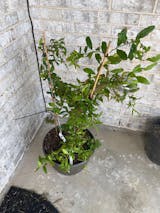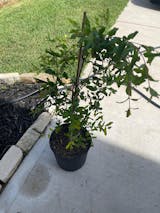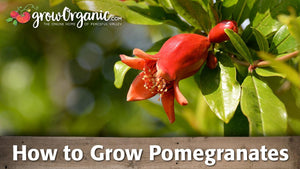Item Number: FT225
Potted Pomegranate Tree - Sweet
Mild, sweet fruit for every palate.
Sweet Pomegranate is a highly desirable sweet pomegranate variety renowned for its richly flavored arils, striking color, and excellent performance in home gardens. This variety produces medium to large fruit with glossy, ruby-red skin and exceptionally sweet, low-acid arils that are perfect for fresh eating, juicing, salads, and dessert garnishes. With a noticeably milder flavor than more tart pomegranates, Sweet Pomegranate is a favorite for those who want a naturally sugary, refreshing fruit straight from the tree.
Ideal for both in-ground planting and containers, Sweet Pomegranate adapts beautifully to patios, balconies, and small garden spaces. The tree thrives in full sun and well-drained soil, showing impressive drought tolerance once established—making it an excellent choice for warm, dry-summer climates. In spring, it erupts with brilliant orange-red blossoms that attract pollinators and set the stage for a generous late-summer to fall harvest. Even in a pot, this compact tree produces consistent yields and remains manageable for pruning and care.
Beautiful, productive, and easy to grow, Sweet Pomegranate brings both ornamental appeal and flavorful fruit to home orchards, Mediterranean-style gardens, and small-space landscapes. Its vibrant blooms, lush foliage, and sweet, juicy arils make it a standout addition for gardeners seeking a compact fruit tree with exceptional taste and dependable performance.
Potted Tree
- Zones: 8-10
- Chill hours: 100
- Harvest: September 8 - October 13
- Looks: Somewhat greenish with a red blush and pink juiced.
- Personality: Much sweeter than many other cultivars.
- Facts of note: Pomegranates are not grafted onto any rootstock, so in areas where it gets cold enough to freeze the tops of the plants back sometimes, they still come back and produce the same fruit. Hummingbirds love the pomegranate flowers. Responds well to being grown as an espalier and in containers. Unsplit fruit stores for up to 2 months. Pomegranates are nice ornamentals with showy orange red spring blossoms. Bears at an early age and is productive. Widely adapted and can tolerate cool summer climates.
- Pollination: Self-pollinated.
The Sweet Pomegranate Tree: A Jewel of the Garden
The Sweet Pomegranate tree, scientifically known as Punica granatum, is a remarkable and cherished addition to any garden. With its vibrant, ruby-red fruit and lush green foliage, this tree not only enhances the aesthetics of your outdoor space but also offers a plethora of health benefits and culinary delights. In this comprehensive guide, we will explore the various facets of the Sweet Pomegranate tree, from its origins to cultivation and its many uses.
A Rich History
The Sweet Pomegranate tree has a rich history dating back thousands of years. Originating in the Middle East, it has been cultivated in regions like Iran, India, and the Mediterranean for millennia. The pomegranate fruit holds a significant place in various cultures and mythologies, often symbolizing fertility, abundance, and prosperity. Its distinctive appearance and symbolism have made it a popular motif in art, literature, and religious texts throughout history.
Characteristics of the Sweet Pomegranate Tree
The Sweet Pomegranate tree is a deciduous shrub or small tree that typically reaches a height of 10 to 20 feet. It boasts glossy, lance-shaped leaves that are a rich, deep green, providing an attractive backdrop for the vibrant fruits. During the spring and early summer, the tree graces the garden with striking orange-red, trumpet-shaped flowers, which are not only visually appealing but also attract pollinators like bees.
Fruitful Bounty: Pomegranates
The main highlight of the Sweet Pomegranate tree is, of course, its fruit. Pomegranates are known for their distinctive appearance, with a tough, leathery outer skin that protects the clusters of juicy, ruby-red arils (seed sacs) inside. These arils are the edible part of the fruit, bursting with a sweet and slightly tart flavor that is both refreshing and delicious.
Cultivating Sweet Pomegranates
Growing a Sweet Pomegranate tree in your garden is a rewarding endeavor. They thrive in regions with hot, arid summers and mild winters. Here are some key considerations for successful cultivation:
Location: Plant your Sweet Pomegranate tree in a sunny spot with well-drained soil. Full sun is essential for fruit production.
Watering: While these trees are relatively drought-tolerant, consistent watering during the growing season is necessary for optimal fruit development. However, be cautious not to overwater, as pomegranates are susceptible to root rot in waterlogged soil.
Pruning: Regular pruning helps maintain the shape of the tree and encourages fruit production. Remove any dead or crossing branches to improve air circulation.
Fertilization: Pomegranate trees benefit from annual fertilization with a balanced, slow-release fertilizer in the spring.
Health Benefits and Culinary Uses
Pomegranates are not only delightful to the taste buds but also offer a range of health benefits*. They are packed with antioxidants, vitamins, and minerals, making them a nutritious addition to your diet. Research suggests that pomegranates may help lower blood pressure, reduce the risk of heart disease, and have anti-inflammatory properties.
In the kitchen, pomegranates are incredibly versatile. You can enjoy them fresh, add them to salads for a burst of flavor and color, or use their juice to make sauces, dressings, and beverages. Pomegranate seeds are also a delightful garnish for desserts and cocktails.
The Sweet Pomegranate tree is a true gem in the world of gardening. With its fascinating history, stunning appearance, and delicious fruits, it adds both beauty and functionality to your outdoor space. Whether you're a seasoned gardener or a novice, cultivating a Sweet Pomegranate tree can be a rewarding experience, offering not only visual pleasure but also a bounty of health benefits and culinary delights. So, consider adding this remarkable tree to your garden and savor the sweetness it brings to your life.
Visit our Fruit Tree Central for a listing of all our fruit tree videos and articles.
Visit Tree Characteristics for a listing of all our fruit & nut tree growing characteristics.
* Not medical advice. See a physicial for details.


Check Your Zone Compatibility:
Compatible with your zone.
Growing Zone for

Our Guarantee To You
Since 1976, we've served our customers at every stage of growing. Please contact us at any time. We are happy to support and assist you.
Shipping Information
Shipping Information
Cannot ship to the following states: HI, AK, PR, GU, VI
Shipping Weight: 5.5 lb
Dimensions: 35.9"L x 3.9"W x 3.9"H
Features
Features
- Flavor Pick
- Potted
- Self-fruitful
- Suited to Warmer Climates
Characteristics
Characteristics
Planting & Care
Planting & Care
Useful Information
Useful Information
Guarantee
Guarantee
We guarantee the perishable items we sell to be in good, viable condition when we sell them. Perishable items include, but are not limited to, garlic bulbs, flower bulbs, seed potatoes, onion sets & transplants, potted or bare root trees, vegetable crowns, etc. If your perishable item arrives in substandard condition, take photographs and please contact us within 3 days of the purchase date (or delivery date) and we will provide you with a refund of the purchase price (excluding shipping costs), or a replacement. Accordingly, we urge you to open any boxes marked as ""Perishable"" immediately upon receiving them and inspect the shipment thoroughly (do not crack open heads of garlic, we do not accept claims on cracked garlic). Because some perishable items can deteriorate very quickly, we cannot accept any claims beyond the 3-day time frame as it becomes too difficult to determine if these items were delivered in substandard condition, or if they turned into such substandard condition because of having been improperly cared for or stored once delivered.
Share
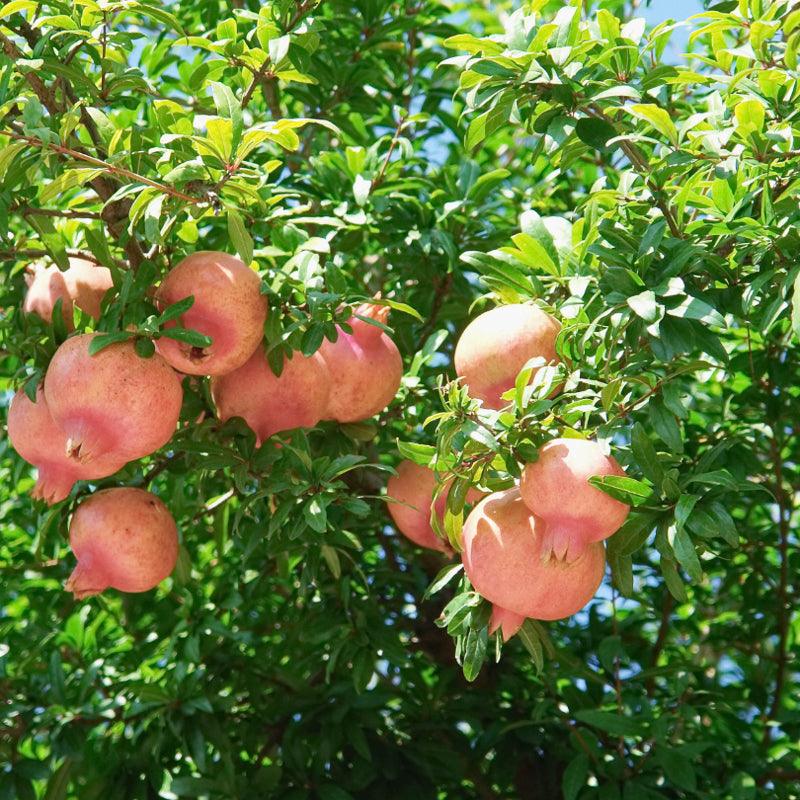
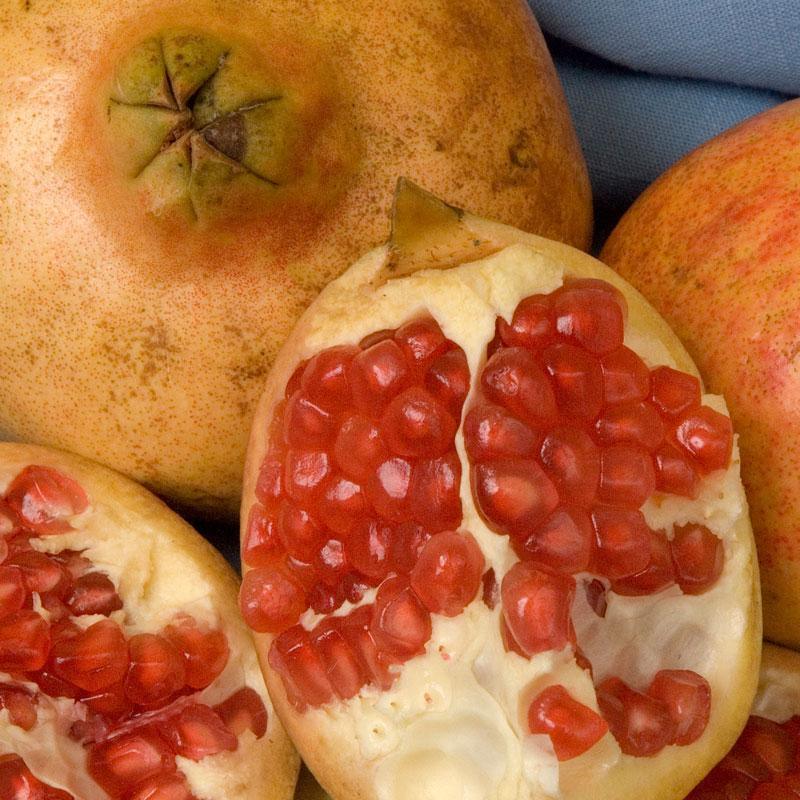
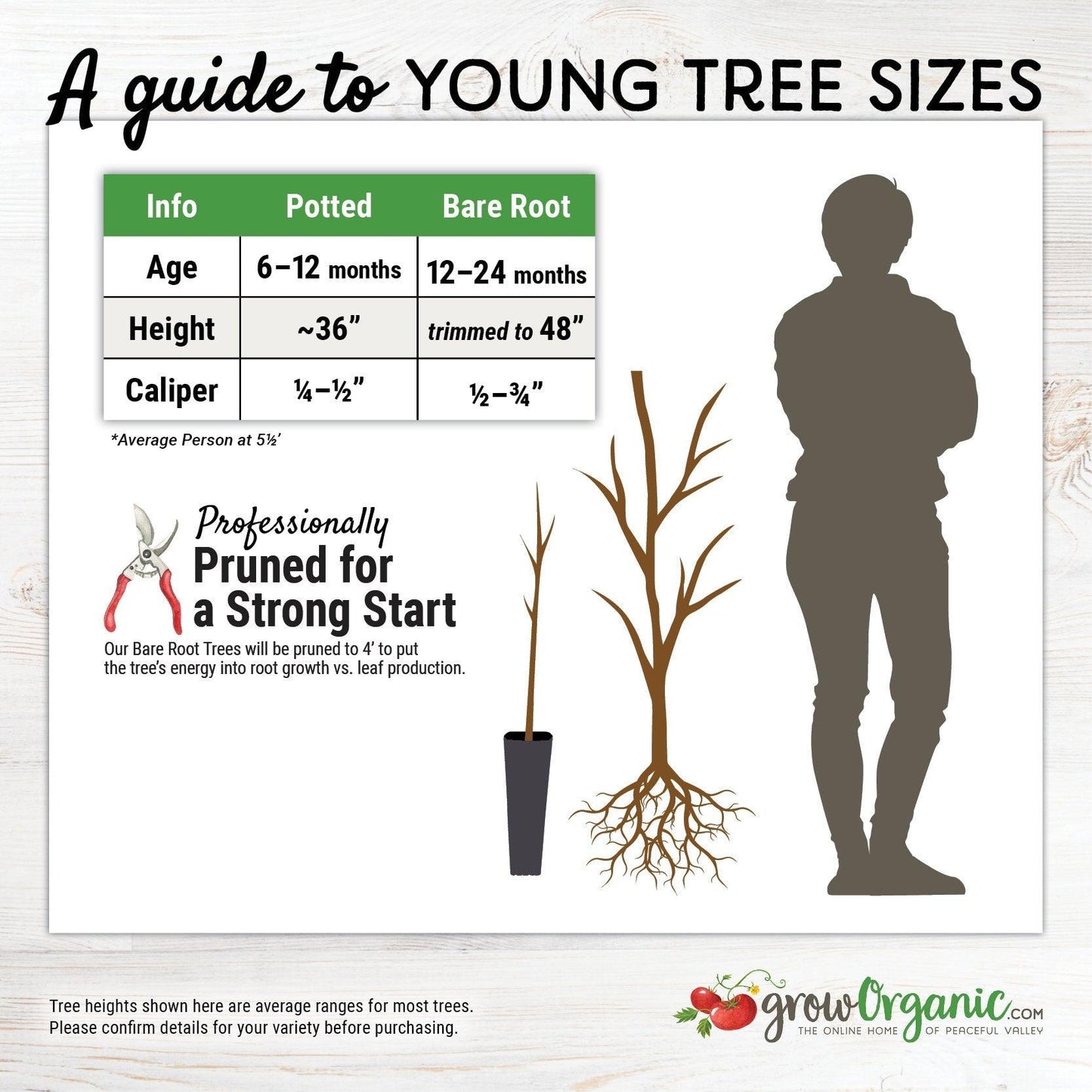
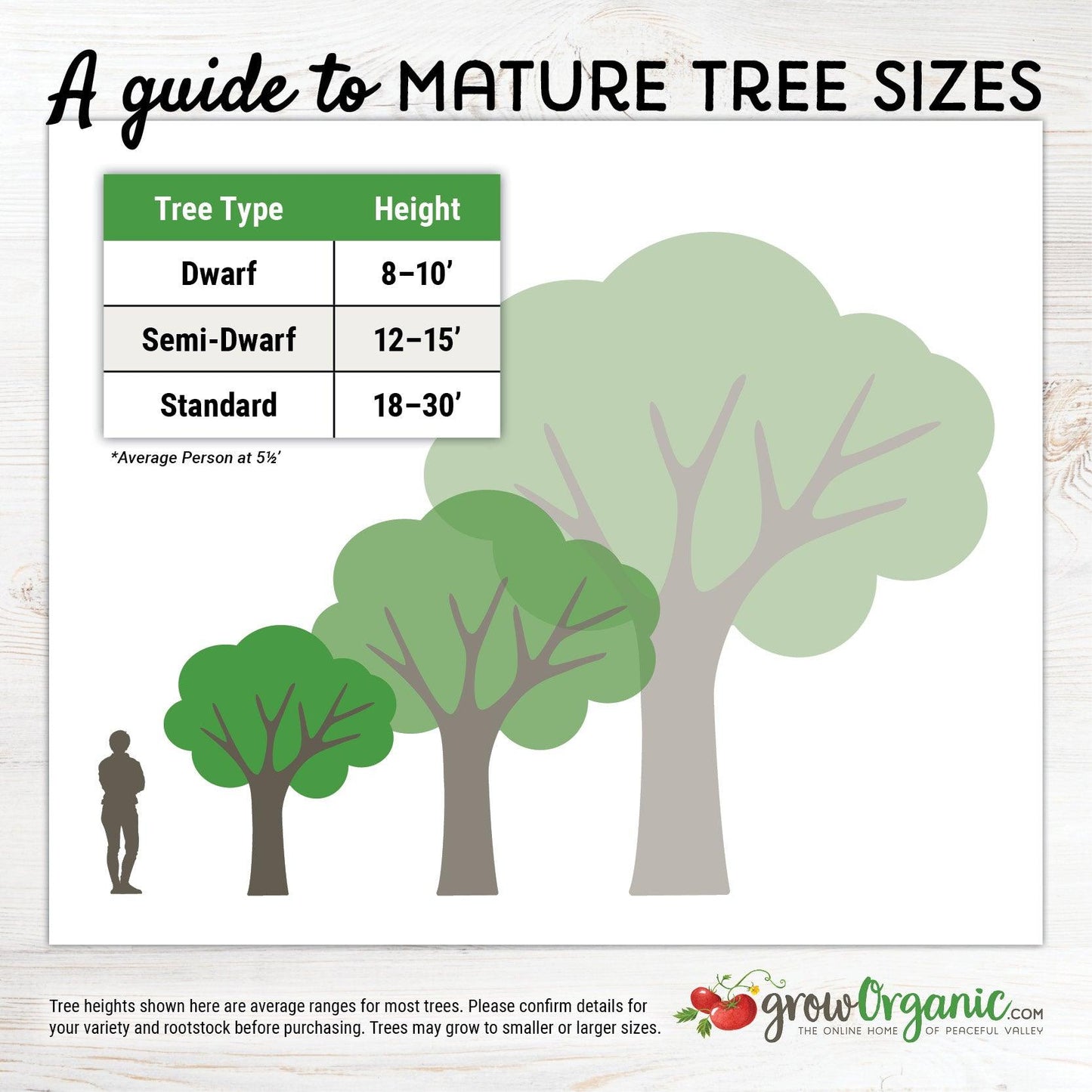
It is still alive, I did not plant them in ground yet , but in a large pot waiting for them to get larger before I plant them .No issue so far. I purchased three plants
See photos
Packaged and shipped well, transplanted with no issues and is full of leaves. Excited for future fruit.
Bare root with great root system. Full of leaves as soon as Spring hit. Great purchase. Highly recommended!
I am mightily please!
It'd only been in the ground 20 months this past weekend when I harvested my first fruits! I've planted a couple Pomegranates over the years, and *this* one is the tree that I've harvested off of first -- and it's my YOUNGEST! It's only about 4.5-foot tall, with lots of side-spreading growth so far, but the fruit was DELICIOUS! The juice was purely sweet, with essentially no tang at all (so different from store-bought ones I'd eaten before!), and the seeds were as soft as an unroasted peanut!
The fruits had started to crack along the skin, but not as a sign of ripeness; Northern California in 2021 had no rain from late-March until October, and then we got 26" in about ten days. This tree, which I planted in FULL SUN (with no mulch, and no watering system, and only got hand-watered by the bucket-full every 7 days at best), absolutely THRIVED in our hot, dry, baking summer! I was shocked when it started to flower in June, and even more so when it set fruits in July, because this tree was still so young and small - -
I *HIGHLY* RECOMMEND THIS POMEGRANATE! (especially if you live in a dry, hot place with mild winters, even if your watering capabilities are limited!)
~Hind & Owl Farms
I received it well packed and already has buds. Healthy and so pleased with the purchase.





